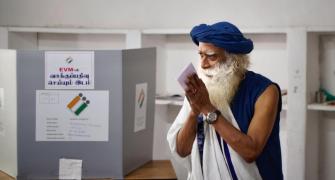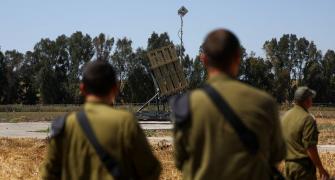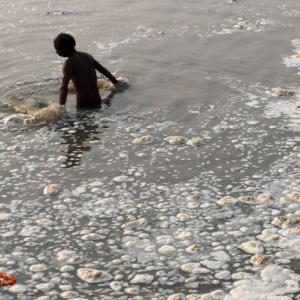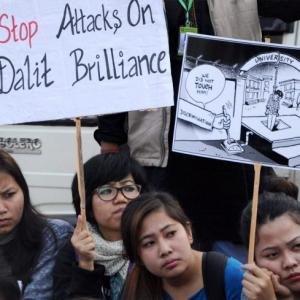In the 66th year of the Indian Republic, eight people died of cold every night in the nation's capital.
Rashme Sehgal reports.

Chilly winter nights kill eight homeless people every day in the national capital.
The Delhi government, adding to their woes, has stopped the practice of providing tea and wood to light a bonfire at night shelters.
164 homeless people have died so far this month due to the cold. Non-governmental organisations operating the night shelters fear the toll may increase as it is getting colder and colder in Delhi.
Sunil Kumar Aledia, head, Centre for Holistic Development, an advocacy group that oversees the functioning of 180 night shelters for the homeless, says the dead also included three women.
One of the women Meera died on Thursday, January 21, in a makeshift shelter at Shakurbasti. She, along with her family, was among the 1,500 families evicted during the demolition drive by the Northern Railways in December.
"Earlier, the Delhi government used to provide tea to the homeless and also supplied every shelter with wood so people could light bonfires at night. But this has been stopped from last year," adds Aledia.
Most of the dead are either old people or men in the 25 to 45 year age group, he believes.
The existing night shelters cannot accommodate the large number of people seeking refuge from the bitter cold.
Delhi currently has 180 night shelters. Out of these, 84 are permanent buildings, 11 are portacabins, two Delhi Metro Rail Corporation cabins and 49 tents. Some of these are just one room tenements.
These shelters can totally accommodate up to 9,000 people. However, according to surveys conducted by some NGOs, the number of homeless in the national capital is close to 300,000.
"Even the homeless do not want to live in tents," points out Usha Nischal, who runs an NGO, Mahila Pragati ki Or (which also provides shelter to homeless men). "Tents have no electricity and the chances of personal belongings being stolen there are also much higher."
Nischal's centre, considered to be one of the best in the city, is located in Tilak Nagar. No inmate is allowed to smoke or drink. She also insists on keeping the place utterly clean.
Activists believe that the Delhi government must increase the number of night shelters on a priority basis.
"Shelters must function throughout the year because extreme heat also affects the homeless as much as extreme cold. Unfortunately, the government's focus is to keep shelters functioning only during the winter. Between the months of April and October, these shelters do not function," says Nischal.
Nischal began her shelter in 2010 with 13 people. It now has over 250 inmates. Although she says there is no shortage of blankets and every inmate can use up to four blankets if required, she acknowledges that overcrowding is a major problem.
According to data collated from the Zonal Integrated Police Network and the ministry of home affairs, the death toll of the homeless crossed 350 in the past six weeks.
As per the ZIPN data, 150 unidentified bodies were found in the capital in the first 20 days of January in Connaught Place, Chittaranjan Park, Civil Lines and Kashmere Gate areas.
"80 per cent of the unidentified bodies are of homeless people," says Aledia.
The Delhi government puts the number of homeless in the city at 16,760, an estimate activists question.
An NGO States Rights Campaign for the Homeless in Delhi puts the number of homeless at 52,765 while the 2001 Census also yielded the same figure. A survey commissioned by the Supreme Court finds the number of homeless in the national capital to be 246,800, which most NGOs believe is the most accurate.
The activists also question the allocation of 250,000 square feet for shelters against the 1.9 million sq ft promised in the Delhi Master Plan for 2021.
Often, women prefer to live on the roadside rather than in the night shelters as they fear sexual assault by other inmates, some of whom are known to be drug addicts.
"I prefer to live under the flyover (near the IIT Gate) with my family because if I am harassed by anyone, I can shout for help," says Sharmila, a native of Kota, Rajasthan.
Many Good Samaritans, she says, give them blankets and quilts to help battle the cold.
For pregnant women, says Aledia, the Delhi government runs two homes in Jehangpuri and Sarai Rohilla.
He cites the case of a pregnant woman who was admitted recently to the Jehangpuri home for lactating and pregnant women where she was able to deliver her child safely.
"In 2015, 12 homeless pregnant women were admitted to these two homes," adds Aldeia.
Shelters in the Trans-Yaumna and Jamuna Pustha areas are much more congested as most migrants in Delhi prefer to live in these areas.
Although, government rules require every shelter to have three caretakers and one cleaner to work 24x7, many of them require better supervision as they lack drinking water and sanitation. Inmates often face victimisation by the caretakers.
The problem of Delhi's homeless can be solved only if the government accepts that their numbers are about fifteen times more than the official figure and tackles the issue on a war footing.










